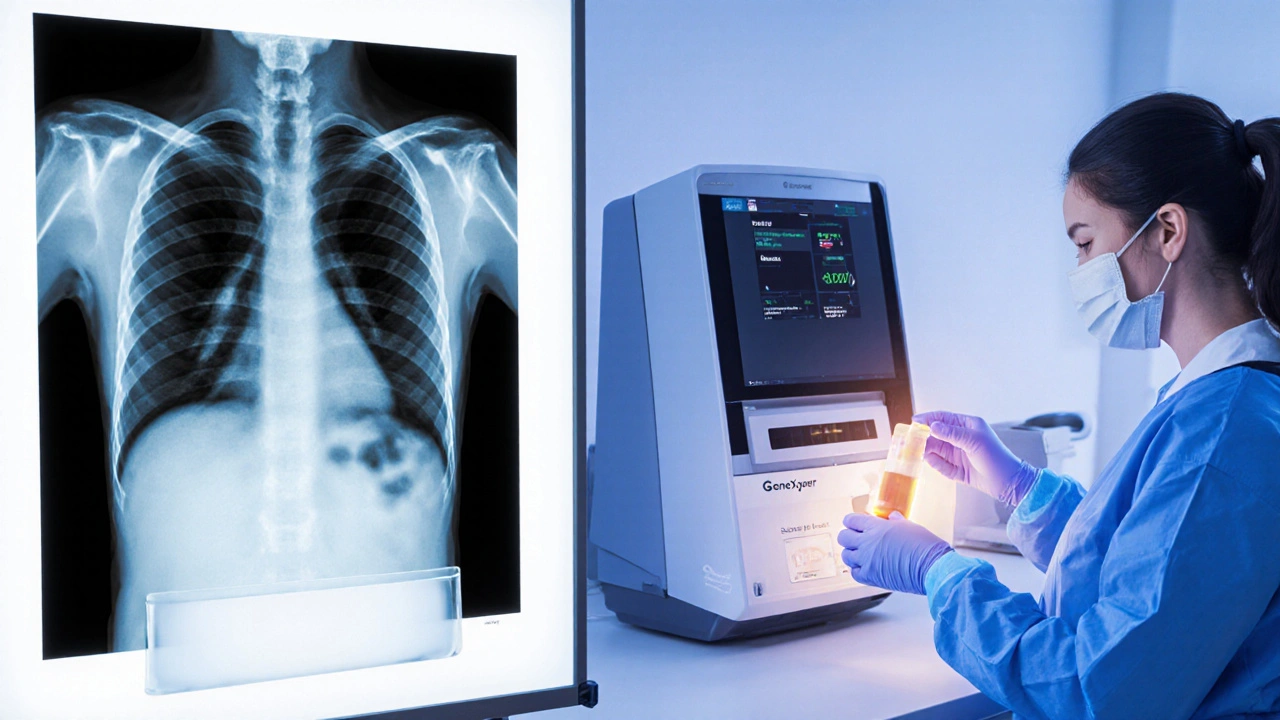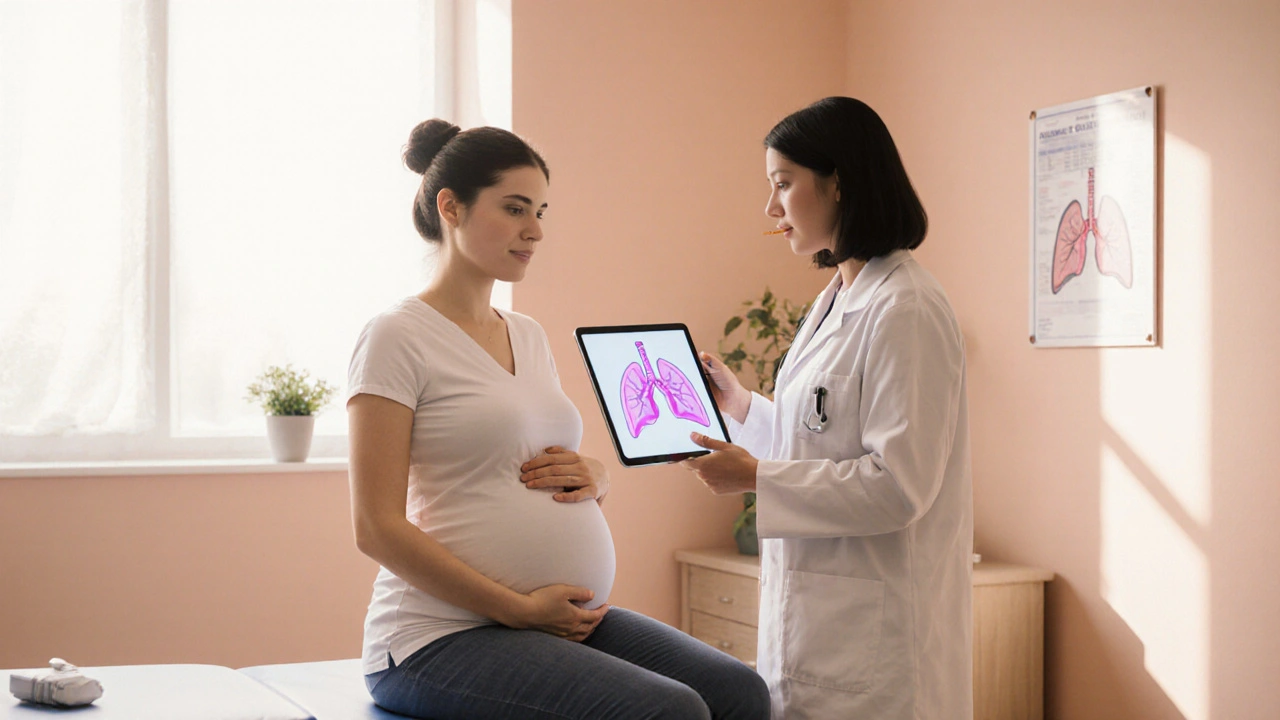Pregnancy TB Risk Assessment Tool
Assessment Results
Key Takeaways
- Untreated pulmonary tuberculosis (TB) significantly raises maternal and fetal complications.
- Chest X‑ray with abdominal shielding and rapid molecular tests are safe diagnostic tools.
- Isoniazid, rifampicin, ethambutol and, after the first trimester, pyrazinamide are WHO‑recommended for pregnant women.
- Close monitoring of liver enzymes, vitamin B6 supplementation, and adherence to DOTS are essential.
- Delivery planning should focus on infection control and postpartum continuation of therapy.
Understanding pulmonary tuberculosis during pregnancy is crucial because the disease can jeopardize both mother and baby while the treatment options are tightly regulated. This guide walks you through the biggest risks, the safest ways to confirm the diagnosis, and the step‑by‑step management plan that aligns with current WHO recommendations.
Pulmonary Tuberculosis is a contagious bacterial infection that primarily attacks the lungs, caused by Mycobacterium tuberculosis. When a woman is pregnant, the immune system shifts to protect the fetus, which can allow latent TB to reactivate or make an active infection harder to control.
Why Pregnancy Changes the TB Landscape
During pregnancy, the body produces higher levels of progesterone and estrogen, which modulate immune responses. This immunological shift can:
- Increase the risk of progressing from latent TB infection to active pulmonary disease.
- Mask classic TB symptoms-fever and night sweats may be attributed to pregnancy itself.
- Elevate the chance of anemia and weight loss, compounding maternal malnutrition.
Maternal complications include severe anemia, pre‑eclampsia, and, in extreme cases, maternal mortality. For the fetus, the biggest concerns are low birth weight, preterm delivery, and, rarely, intrauterine infection.
Safe and Accurate Diagnosis
Prompt diagnosis is the cornerstone of a good outcome. Fortunately, most modern TB tests are safe for the pregnant uterus.
GeneXpert (or Xpert MTB/RIF) is a rapid molecular assay that detects TB DNA and rifampicin resistance in under two hours. It uses a sputum sample and involves no radiation, making it ideal for first‑trimester screening.
If a chest X‑ray is needed, the procedure can be performed with a lead apron over the abdomen; radiation exposure to the fetus is less than 0.01mGy-well below the threshold for any harmful effect. The image helps assess disease extent, especially for cavitary lesions that could affect treatment duration.
Traditional sputum smear microscopy still has a role in low‑resource settings, but its sensitivity drops in pregnancy due to reduced cough effort. Combining smear, culture, and GeneXpert yields the highest detection rate.
Drug‑Safe Management Plan
The WHO’s “CategoryC” classification for anti‑TB drugs in pregnancy reflects the balance between maternal benefit and fetal risk. The recommended regimen-often called the “short‑course” or “first‑line” regimen-includes four drugs:
| Drug | WHO Pregnancy Category | Trimester Recommendation | Key Monitoring Point |
|---|---|---|---|
| Isoniazid | C | All trimesters | Liver enzymes; give vitaminB6 (pyridoxine) 25mg daily |
| Rifampicin | C | All trimesters | Monitor liver function; watch for drug‑drug interactions |
| Ethambutol | C | All trimesters | Check visual acuity at baseline and monthly |
| Pyrazinamide | C (recommended after 1st trimester) | 2nd & 3rd trimesters | Liver enzymes; avoid in first trimester unless benefits outweigh risks |
Key points for the regimen:
- Start all four drugs as soon as TB is confirmed; delaying pyrazinamide until the second trimester is acceptable.
- Give pyridoxine (vitaminB6) with isoniazid to prevent peripheral neuropathy-a risk heightened in pregnancy.
- Continue therapy for the standard six months (intensive phase 2months, continuation phase 4months). Extending beyond six months is only needed for cavitary disease or drug resistance.

Monitoring, Adherence, and Safety Checks
Active supervision through DOTS (Directly Observed Therapy, Short‑course) remains the gold standard. For pregnant women, the monitoring checklist includes:
- Baseline liver function tests (ALT, AST) before therapy.
- Monthly ALT/AST during the intensive phase; more frequent if symptomatic.
- Visual acuity testing at baseline and each month for ethambutol.
- Hemoglobin and iron status every trimester to catch anemia early.
- Fetal growth ultrasounds at 20weeks and 32weeks.
If transaminases rise >3× the upper limit of normal with symptoms, pause isoniazid and rifampicin, then re‑introduce one drug at a time under close observation.
Special Situations
HIV Co‑infection
When a pregnant woman is also living with HIV, integrate antiretroviral therapy (ART) with TB treatment. Rifampicin induces cytochromeP450, lowering levels of many protease inhibitors. Switch to efavirenz‑based regimens, which remain safe in pregnancy, or adjust dosing under specialist guidance.
Multi‑Drug‑Resistant TB (MDR‑TB)
MDR‑TB (resistant to at least isoniazid and rifampicin) requires second‑line agents such as levofloxacin, ethionamide, or bedaquiline. Safety data are limited, so treatment should be managed in a specialized TB center with a multidisciplinary team. Close fetal surveillance and counseling are mandatory.
BCG Vaccination for the Newborn
The Bacille Calmette‑Guérin (BCG) vaccine is contraindicated for infants whose mothers received live‑attenuated TB vaccines during pregnancy, but it is safe for babies born to mothers on standard chemotherapy. The decision follows national immunisation schedules-most UK guidelines advise BCG only for high‑risk newborns.
Delivery Planning and Postpartum Care
Mode of delivery (vaginal vs. caesarean) should be based on obstetric indication, not TB status. However, infection control measures-such as using a negative‑pressure operating theatre for active pulmonary disease-reduce aerosol exposure to staff.
After birth, continue the full TB regimen for at least six months. Breastfeeding is encouraged; isoniazid, rifampicin, ethambutol, and pyrazinamide are excreted in milk at levels far below therapeutic thresholds, and the benefits of breastmilk outweigh any theoretical risk.
Common Pitfalls and Pro Tips
- Pitfall: Assuming pregnancy protects against TB progression. Tip: Screen all high‑risk pregnant women (e.g., close contacts of TB patients) with interferon‑gamma release assays (IGRAs) early in pregnancy.
- Pitfall: Ignoring liver toxicity because symptoms mimic pregnancy nausea. Tip: Schedule routine liver panels regardless of how the patient feels.
- Pitfall: Skipping pyridoxine supplementation. Tip: Make vitaminB6 a mandatory part of every prescription.
- Pitfall: Delaying treatment due to fear of teratogenicity. Tip: Explain that untreated TB poses a far greater fetal risk.
Frequently Asked Questions
Can a pregnant woman take a chest X‑ray?
Yes. With abdominal shielding, fetal radiation exposure is negligible (under 0.01mGy). The diagnostic benefit outweighs the tiny risk.
Is the BCG vaccine safe for my baby if I have TB?
BCG is safe for newborns of mothers on standard anti‑TB therapy. It is only withheld if the mother received a live‑attenuated TB vaccine during pregnancy, which is rare.
What should I do if I feel nauseous and think my liver enzymes are high?
Contact your TB nurse immediately. Get blood tests to check ALT/AST. If levels are markedly elevated, the clinician may pause isoniazid and rifampicin, then re‑introduce them gradually.
Can I breastfeed while on TB medication?
Breastfeeding is strongly recommended. First‑line TB drugs pass into milk in very low amounts that do not harm the infant.
How often should I see my doctor during treatment?
During the intensive phase (first 2months), visits are weekly for DOTS observation and liver tests. In the continuation phase, monthly check‑ins are sufficient unless complications arise.

